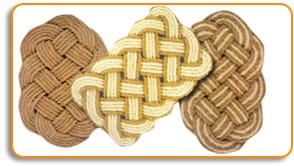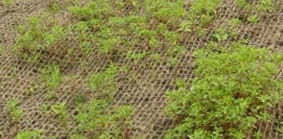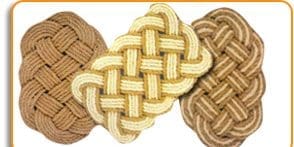Abstract
Coir is a versatile lingo-cellulosic fiber obtained from coconut trees (Cocos nucifera). Coir is available in large quantities, in the order of 5 million tons a year globally. The export of coir and coir products from India was Rs. 2757.90 crore for the year 2019-20. Registering an all-time high record, which was around Rs. 30 crores higher than that of the last year i.e., 2018-19 at Rs. 2728.04 crore. While the exports of coir pith, tufted mats, coir Geo-textiles, coir rugs and carpets, coir ropes and power-loom mats grew both in terms of quantity and value. The products like hand-loom mats, coir yarn, rubberized coir and power-loom matting showed a decline in terms of the quantity and increase in terms of value. Coir pith with export earnings of Rs. 1349.63 crore constituted 49% of the total export of coir products from the country. The value-added items put together constituted 33% of the total exports. The best way to bring the existing coir industry to a higher level is the development of new value-added coir products. This review article throws light on the opportunities in coir spinning and the various value-added coir products for Export.
Introduction
Coir is the fibre obtained from the fruit of coconut tree (Cocos nucifera). It belongs to the palm tree family (Arecaceae) grown in tropical and sub-tropical countries [1]. Coconut fruit consists of exocarp (the outer husk), mesocarp (the fibrous husk), endocarp (the hard shell) and the endosperm (the meat) [2]. Coir fibre is extracted from the coconut fruit after the removal of husk after the removal of the endocarp and the endosperm. The husk consists of 75% of fibre material and 25% fine material called pith [3]. Though coconut tree grows in several countries, majority of fibre extraction takes place in countries like India, Sri Lanka and Philippines. Less than 50% of coconut husk are utilised for fibre extraction and remaining husks are used as domestic fuel and left over as waste which decomposes in due course of time. Coir fibre consists of 43.44% of cellulose, 45.84% of lignin, 0.25% of hemi cellulose, 3.00% of pectin, 2.20% of ash and 5.25% of water-soluble compounds [4]. Due to the high quantity of lignin, coir fibre is brown, stiff and has high flexural rigidity [5].
Two types of of course fibres are available in the coir industry like white fibre and brown fibre [6]. Fibre obtained from the immature green husk after a long retting process of 10 to 12 month is known as white fibres. Brown fibres are extracted from matured husk with a getting process of 10 days.
Spinning of coir fibres has been carried out in India, Sri Lanka and Thailand. Coir fibre yarn is produced by the traditional hand spinning process and the mechanised spinning process. Hand spinning is being carried out by women workers in the rural regions of Kerala and provides livelihood to a sizable women population. Mechanised spinning process has got its importance as the demand for coir yarns is not fulfilled by the low production of hand spinning process [7]. Most of the white fibres are processed in hand spinning and the brown fibres are processed in the mechanised spinning system.
Coir Fibre Industry in India
Coir Industry in India, manufactures yarns, mats, mattings and other products using age-old processes due to which the quality of the products leaves much to be desired. The fibre properties and chemical composition are given below in Table 1. and Table 2. respectively:
Table 1. Physical Properties of Coir Fibers
| Property | Value |
| Length/Breadth Ratio (L/B) | 95.0 |
| Fineness (tex) | 35.0 |
| Tenacity (g/tex) | 20.0 |
| Breaking Load (kg) | 0.45 |
| Extension at break (%) | 25.0 |
| Flexural rigidity (dynes/cm2) | 200.0 |
| Density (g/cc) | 1.40 |
| Porosity (%) | 40.0 |
| Moisture regains at 65% RH (%) | 10.50 |
Table 2. Chemical Composition Coir Fibers (% by mass on dry basis)
| Composition | Fiber from Old Nuts | Fiber from Young Nuts |
| Cellulose | 43.44 | 32.86 |
| Hemicellulose | 0.25 | 0.15 |
| Lignin | 45.84 | 41.54 |
| Pectic substances | 3.00 | 2.75 |
| Water soluble matters | 5.25 | 20.00 |
| Ash content | 2.06 | 2.50 |
Spinning
Spinning is mostly done manually. The output is low, and the nature of work is tiresome. Mechanised ratts are available, but in most of the cases, the quality of yarns from these ratts does not conform to the exporter’s quality requirements. Majority of the coir yarns spun using mechanized ratts are manufactured with cotton or polyester filament as core. Whenever cotton is used as core, the cost of the resultant coir yarn increases and when polyester filaments are used as core, the eco-friendly nature of the coir product is affected.
Hand Spinning
The usual practice in hand spinning is to roll the fibre into short length of 6 to 9 inches, giving a clockwise twist by hand. When enough has been made, two of these short lengths are taken in hand together and made into yarn of two plies by giving a counter twist, using both palms? When the counter twist reaches near the end of the striking, further pieces of short lengths that are kept ready, are added one after other, while the Counter twist by hand is continued, till the required length of yarn for a knot is reached. This is reeled in the form of a hank and a knot is made at the end. Handspun yarn always has a soft twist.
Traditional Ratt Spinning
Since the middle of the 19th century, coir spinning wheels or ‘Charka’ have been introduced with a view to increasing production and obtaining the hard twist required for the manufacture of matting, etc. Wheel spinning is gradually displacing hand spinning. To prepare two-ply coir yarn on the spinning wheel, one set of two wheels, one stationary and the other movable is required. The stationary wheel usually contains two spindles set in motion through the centre of the wheel. The movable wheel contains one spindle only. Two persons take the silvers of ‘coir’ prepared and kept ready after willowing. Usually, women keep them in their arm pits, make a loop with a small quantity of fibre and then puts the loop thus formed into the notch of one of the spindles on the stationary wheel and gives the fibre a uniform thickness while walking backward. Another operator then gives the twist to the fibre; thus, led by turning the handle of the spinning wheel. This operation is continued till the required length of strand is reached.
The strands are then passed through a grooved rod and tied together into the notch of the spindle; the grooved rod being allowed to move forward. The movable wheel is turned in the opposite direction. The object of the grooved rod is to regulate the twist of the yarn and to prevent entanglement of the strands at the time of doubling. When the grooved rod reaches the stationary wheel, the turning of the spindles of the spinning wheel is stopped and all the ends from that of the stationary wheel are cut off and the yarn is tested to see whether there is sufficient twist. If more twist is required, the movable wheel is turned toward its original direction till the required twist is obtained, if it contains more twist than desired, the movable wheel is turned in a direction contrary to the original twist. Traditional Wheel spinning using a spinning wheel requires three people, who may produce 12-15 kg of yarn per day.
Motorised Traditional Ratt
Motorised Traditional Ratt is a developed form of a coir spinning ‘charka’. Here, the stationary ratt is rotated using a suitable contrivance attached to an electric motor. By attaching the rotating system to the stationary ratt one worker is avoided and the productivity is increased. The wages thus earned are divided among the two workers resulting in enhancement of wages of spinners. This system has been introduced recently and found successful in the industry for spinning all varieties of yarn.
Motorised Ratt
The research and development in coir industry was mainly aimed for reducing the drudgery of the workers involved in the spinning of coir yarn on traditional and motorised traditional ratts. Two or three spinners are engaged for exercising the production activity in yarn spinning, where they are exposed to changing weather conditions, which ultimately affects the production. They are also forced to walk up and down in the spinning yard for taking the individual strands and for doubling operation. As a result of research and development, a spinning device for reducing the drudgery, improving the productivity and to improve the working environment, the motorised ratt was introduced in the industry. In the case of a motorised ratt the spinner is made to sit on a chair /stool and roll the well cleaned fibre stacked in the spinning trays attached to the spinning device where the yarn is spun and wound over the bobbins attached to the ratt.
Automatic Spinning
The production turnover in the case of hand spinning was less. The efforts to maximise the productivity of the yarn resulted in the introduction of automatic spinning machine units.The automatic spinning machine units are capable of production of yarns of runnage varying from 50 to 300 meters/kg and twists from 10 to 30 twists/feet.
Coir fibre in the form of bales is the raw material for the unit. These fibres are soaked in water for one hour and are cleaned in the willowing machine. Pith content and the hard bits are removed in the process. Manual attention is also required for this removal, to the fullest extent. The cleaned fibers are passed into the feeder of silvering machine, where the fibers are paralleled and drawn by draw rollers. These paralleled fibers are twisted and taken on to drum. The twisted paralleled fibers are called silvers. The silvers are fed on to the feeder of the spinning machine, combed and to made to fall on to “W” tray. Core threads of nylon/cotton/HDPE/LDP Eassing in the tray are used as carrier for the coir fibres. These fibres are entwined on to the thread and are twisted by the grip nozzles/rollers. Two such strands are doubled and wound on to a bobbin to form the yarn of required twist and runnage. The automatic spinning machine facilitates spinning of varieties of yarns according to the requirement of the industry. By varying the parameters of the machine to vary the twist and/or runnage. The yarns thus formed are wound in the form of balls for the easy transportation.
Weaving
Majority of coir mats and mattings are manufactured in handlooms. Automatic looms are sparingly used in the coir industry. It is mainly due to the exorbitantly high cost of the automatic looms. At present, automatic looms for coir weaving are not manufactured indigenously but imported. Development of heavy-duty cost-effective looms will provide a solution for manufacturing better quality mats and mattings at a relatively lower cost.
Dyeing and Bleaching
Even though some of the exporters have modern dyeing and bleaching facilities with effluent treatment plants; majority of the dyeing and bleaching activities are carried out with lower level of technology. There is scope for setting up better dyeing and bleaching houses, at least in the case of medium scale exporters/manufacturers.
Finishing
The finishing operations like shearing, stitching, stenciling, clipping etc. are done manually or by operating with lower level of technology. Clipping of the mats is performed by using a pair of scissors, which is cumbersome. Some of these processes could be mechanized for removing human drudgery and for improving product aesthetics.
Value Added Coir Products
Coir Fibre is extracted from the fibrous outer cover of the fruit of the Coconut palm, with or without retting. Coir Fibre is graded based on its nature of extraction, colour, presence of long and short fibres, impurities etc.



Bristle Fiber Retted Fiber Coir Yarn
Coir Yarn is generally of 2 ply, spun from coir fibre by hand as well as with the help of traditional ratts, fully automatic spinning machines etc. The Coir yarn is of different qualities/grades based on the quality of fibre used, the nature of twist, presence of impurities etc. Available in different forms like hydraulically pressed bales, spools bobbins, dholls, balls etc. cut length for various industrial and agricultural purposes.
Creel mats are manufactured both on handlooms and powerlooms. They are specially noted for their low pile height. The yarn for the pile structure is released from the beam during the weaving process. The pile structure is obtained by suitable positioning of the coir yarn in the fabric structure with the use of grooved rods and cutting the yarn passing over the rods with a sharp knife. These are available in solid shades, stripes, mottled, stenciled, and tile patterns. 2-chain creel mats and 3- chain creel mats are available in this category. 3-chain creel mats have a firmer structure than 2-chain creel mats. Special type of mats with jute twine sold under the name ‘carnatic mats. Coir Mats are made on handlooms, power looms or frames and with or without brush. Creel Mats are known for its thin brush. Rod Mats for thick brush and Fibre Mats for compact brush. Latex/rubber backing makes the mats non-slip. Available with woven or stenciled designs and bevelled patterns for use in interior or exterior door fronts.




Coir Mats
Matting mats
Coir mattings are cut into the sizes of mats and the edges are finished with all around rubber edging or tucked-in edges. Latex backing or rubber sheet backing are also reported in the manufacture of these mats to give a firm look for the product. These are mostly available in all fancy shades, woven patterns etc.




Matting Mats
Made on traditional handlooms or powerlooms. Available in natural beach, solid colours and a multitude of designs/patterns made by weave and colour combinations and with or without latex backing. Quality of the matting is determined by the type of yarn and weave used. Mainly used as floor coverings and floor runners for furnishing stairs/corridors. Also used for wall panelling, ceiling, lining and echo-control.Coir Mattings are cut to rug size, ends bound, tucked-in, fringed or rubber sealed for use as area rugs. Also available with cotton/tapestry bound and with or without latex backing.




Coir Non-Woven Mats
Coir Geotextiles protect the land surface and promote quick vegetation. Geotextiles are natural eco-friendly, used in erosion control blankets in woven and non-wovens. Totally biodegradable, geotextiles help soil stabilisation and renew vegetation in varying slopes. A spongy material that binds the coconut fibre in the husk, coir pith is finding new applications. It is an excellent soil conditioner and is being extensively used as a soil-less medium for agri-horticultural purposes. With its moisture retention qualities, coir pith is ideal for growing anthuriums and orchids. Available in raw form or converted into organic manure.




Coir Geo-Textiles
Products made out of Coir fibre. From poles to plant pots to hanging baskets, coir makes just about every accessory that is essential for modern day gardening. Coconut husk chips also are widely used in horticultural applications.

Horticulture Coir Products (Source: Coirboard)
Conclusions
The Indian coir industry is an important cottage industry contributing significantly to the economy of the major coconut-growing States and Union Territories such as Kerala, Tamil Nadu, Andhra Pradesh, Karnataka, Maharashtra, Goa, Orissa, Assam, Andaman & Nicobar, Lakshadweep and Puducherry. About 5.5 lakh get employment, from this industry. Coconut husk is the basic raw material for coir products. At least 50 per cent of the available coir husk is used to produce coir products. The rest is used as fuel in rural areas. Hence, there is scope for growth of coir industry. Efforts have also been made to widen export markets for coir and coir products. The rising demand for coir, an expanding market for coir-based erosion control products, and the spread of coir pith as a peat moss substitute in horticulture resulted in higher production and prices. To India’s advantage, it exports largely value-added products yarn, mats, and rugs. The challenge now for industry is to sustain/expand markets for this versatile renewable resource, while maintaining its role as employer for the rural people. This may require producers to innovate production, improve product consistency, and develop novel applications jointly with their customers in importing countries.
Acknowledgements
The Author wish to thank the Management of GRG Institutions, Coimbatore for their constant encouragement and motivation to carry out this work.
References
- S.Sengupta, G.Basu, R.Chakraborty and C.J.Thampi, Stochastic analysis of major physical properties of coconut fibre Indian Journal of Fibre and Textile Research,39(1),(2014),pp 14-23.
- http://agritech.tnau.ac.in/horticulture/horti_pcrops_coconut_botany.html (2014)
- J. Raviv and Heinrich Lieth, Soilless Culture: Theory and Practice, Elsevier Science, (2007).
- D.S.Varma, M.Varma and I.K.Varma,Thermal Behaviour Coir Fibres Thermochin Acta, 108, (1986), pp199-210.
- H.D.Rozman, K.W.Tan, R.N.Kumar, A.Abubakar, Z.A.Mohd. Ishak and H.Ismail,The effect of lignin as a compatibilizer on the physical properties of coconut fiber –polypropylene composites Europen Polymer Journal, 36(7), (2000), pp.1483-1494.
- Meenatchisundaram R I, Retting of Coir –A review, Ceylon Cocon. Plrs.Rev.7, (1980), pp.20-28.
- Leena Mishra, Gautam Basu and Asish Kumar Samanta, Effect of Chemical Softening of coconut Fibres on Structure and properties of its blended yarn with Jute, Fibres and Polymers, 18(2), (2016), pp 357-368.
- www.coirboard.gov.in
Author:
Dr.J.Anandha Kumar M.Tech. Ph.D.
Lecturer, Department of Textile Processing, GRG Polytechnic College,
Coimbatore

